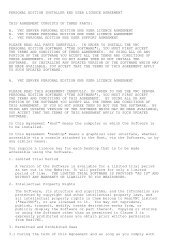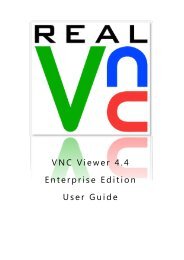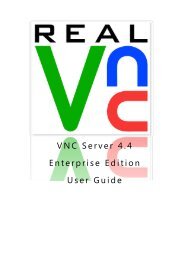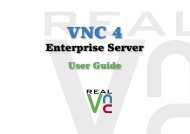VNC User Guide - RealVNC
VNC User Guide - RealVNC
VNC User Guide - RealVNC
You also want an ePaper? Increase the reach of your titles
YUMPU automatically turns print PDFs into web optimized ePapers that Google loves.
Chapter 6: Setting Up <strong>VNC</strong> Server<br />
Licensing <strong>VNC</strong> Server<br />
<strong>VNC</strong> Server must be licensed. If it is not, users cannot connect.<br />
For more information on the different types of license available, to compare the remote control features<br />
provided by each, and to obtain a permanent or a trial license key, visit www.realvnc.com/products/vnc/<br />
licensing/.<br />
Applying a license key<br />
You can apply a license key to <strong>VNC</strong> Server at any time.<br />
You typically do this when you download and install <strong>VNC</strong> Server. You may subsequently do so in order to<br />
renew a support and upgrades contract.<br />
1. Open the <strong>VNC</strong> Server shortcut menu. More on this menu.<br />
2. Choose Licensing. The <strong>VNC</strong> Server - Licensing dialog opens.<br />
3. Follow the instructions. Note you may additionally be prompted to configure <strong>VNC</strong> Server; see<br />
Harmonizing <strong>VNC</strong> Server on page 72 for more information.<br />
Note: If you do not have access to a graphical user interface when you need to apply a license key, use the<br />
vnclicense command line tool instead. For more information, run the command vnclicense -help<br />
from the directory in which <strong>VNC</strong> programs are installed.<br />
Harmonizing <strong>VNC</strong> Server<br />
When you apply a license key you may additionally be prompted to configure <strong>VNC</strong> Server. This is typically<br />
because your license key entitles you to fewer Real<strong>VNC</strong> remote control features than <strong>VNC</strong> Server is<br />
currently configured to use. You must harmonize <strong>VNC</strong> Server with the license key.<br />
For example, if at the end of a trial you choose to downgrade to <strong>VNC</strong> Server (Free), you must turn off<br />
encryption and system authentication. If you do not, users cannot connect.<br />
Note that it is possible to run more than one instance of <strong>VNC</strong> Server on a computer (see Running multiple<br />
instances of <strong>VNC</strong> Server on page 78). If this is the case, you must harmonize all running instances<br />
separately. For example, if under UNIX/Linux you have five instances of <strong>VNC</strong> Server running, two in <strong>User</strong><br />
Mode and three in Virtual Mode, and you apply the new license key to the licensing wizard of a particular<br />
instance of <strong>User</strong> Mode, then you must separately configure:<br />
• The other instance of <strong>User</strong> Mode.<br />
• All three instances of Virtual Mode.<br />
Until you do, users will not be able to connect to these instances. Note that administrative privileges may be<br />
required to perform this operation if you are not the user who started <strong>VNC</strong> Server.<br />
Understanding license scope<br />
Under Windows, a <strong>VNC</strong> Server license key is system-wide. This means it applies to all users with accounts<br />
on the computer. Since only two instances of <strong>VNC</strong> Server can run concurrently on a Windows computer<br />
(one in Service Mode, and one in <strong>User</strong> Mode for the currently logged on user), this means that <strong>VNC</strong> Server<br />
is always licensed for all users.<br />
72 <strong>VNC</strong> <strong>User</strong> <strong>Guide</strong>
















